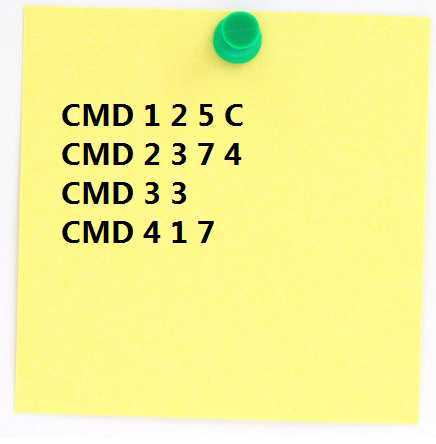标签:des style blog http color io os ar for


Finally, you come to the interview room. You know that a Microsoft interviewer is in the room though the door is locked. There is a combination lock on the door. There are N rotators on the lock, each consists of 26 alphabetic characters, namely, ‘A‘-‘Z‘. You need to unlock the door to meet the interviewer inside. There is a note besides the lock, which shows the steps to unlock it.
Note: There are M steps totally; each step is one of the four kinds of operations shown below:
Type1: CMD 1 i j X: (i and j are integers, 1 <= i <= j <= N; X is a character, within ‘A‘-‘Z‘)
This is a sequence operation: turn the ith to the jth rotators to character X (the left most rotator is defined as the 1st rotator)
For example: ABCDEFG => CMD 1 2 3 Z => AZZDEFG
Type2: CMD 2 i j K: (i, j, and K are all integers, 1 <= i <= j <= N)
This is a sequence operation: turn the ith to the jth rotators up K times ( if character A is turned up once, it is B; if Z is turned up once, it is A now. )
For example: ABCDEFG => CMD 2 2 3 1 => ACDDEFG
Type3: CMD 3 K: (K is an integer, 1 <= K <= N)
This is a concatenation operation: move the K leftmost rotators to the rightmost end.
For example: ABCDEFG => CMD 3 3 => DEFGABC
Type4: CMD 4 i j(i, j are integers, 1 <= i <= j <= N):
This is a recursive operation, which means:
If i > j: Do Nothing Else: CMD 4 i+1 j CMD 2 i j 1For example: ABCDEFG => CMD 4 2 3 => ACEDEFG
1st line: 2 integers, N, M ( 1 <= N <= 50000, 1 <= M <= 50000 )
2nd line: a string of N characters, standing for the original status of the lock.
3rd ~ (3+M-1)th lines: each line contains a string, representing one step.
One line of N characters, showing the final status of the lock.
Come on! You need to do these operations as fast as possible.
7 4 ABCDEFG CMD 1 2 5 C CMD 2 3 7 4 CMD 3 3 CMD 4 1 7
HIMOFIN
1 #include <iostream> 2 #include <stdlib.h> 3 #include <cstdio> 4 #include <string> 5 #include <vector> 6 #include <stack> 7 #include <map> 8 #include <queue> 9 10 using namespace std; 11 12 void cmd1(string &str, int i, int j, char c) { 13 for (int m = i; m <= j; ++m) { 14 str[m - 1] = c; 15 } 16 } 17 18 void cmd2(string &str, int i, int j, int k) { 19 for (int m = i; m <= j; ++m) { 20 int v = (str[m - 1] - ‘A‘ + k) % 26; 21 str[m - 1] = ‘A‘ + v; 22 } 23 } 24 25 void reverse(string &str, int i, int j) { 26 while (i < j) { 27 swap(str[i], str[j]); 28 i++, j--; 29 } 30 } 31 32 void cmd3(string &str, int k) { 33 reverse(str, 0, k - 1); 34 reverse(str, k, str.length() - 1); 35 reverse(str, 0, str.length() - 1); 36 } 37 38 void cmd4(string &str, int i, int j) { 39 if (i > j) return; 40 //cmd4(str, i + 1, j); 41 //cmd2(str, i, j, 1); 42 for (int m = i; m <= j; ++m) { 43 int v = (str[m - 1] - ‘A‘ + m - i + 1) % 26; 44 str[m - 1] = ‘A‘ + v; 45 } 46 } 47 48 int main(int argc, char** argv) { 49 int n, m; 50 cin >> n >> m; 51 string input; 52 cin >> input; 53 54 for (int step = 0; step < m; ++step) { 55 string cmd; 56 int type, i, j, k; 57 char c; 58 cin >> cmd >> type; 59 if (type == 1) { 60 cin >> i >> j >> c; 61 cmd1(input, i, j, c); 62 } else if (type == 2) { 63 cin >> i >> j >> k; 64 cmd2(input, i, j, k); 65 } else if (type == 3) { 66 cin >> k; 67 cmd3(input, k); 68 } else if (type == 4) { 69 cin >> i >> j; 70 cmd4(input, i, j); 71 } 72 //cout << input << endl; 73 } 74 75 cout << input << endl; 76 return 0; 77 }
老是TLE。估计是递归开销太大了。分析了一下改成迭代的了。也不知道对不对。。。
标签:des style blog http color io os ar for
原文地址:http://www.cnblogs.com/linyx/p/4036175.html